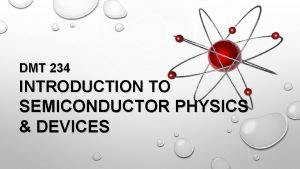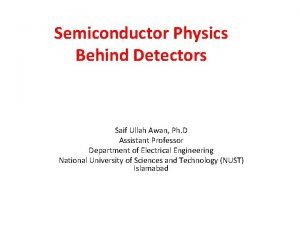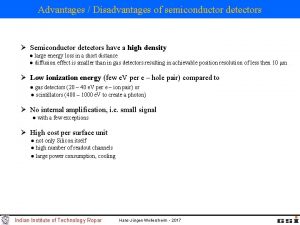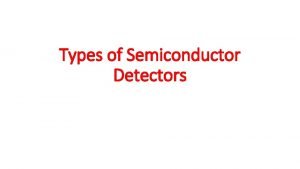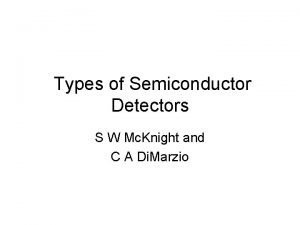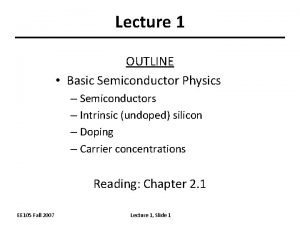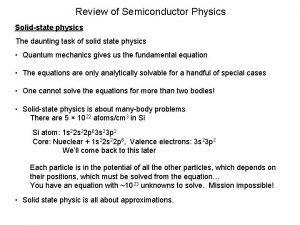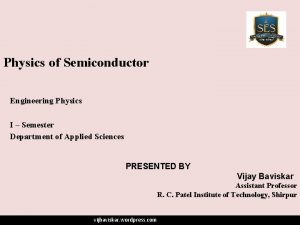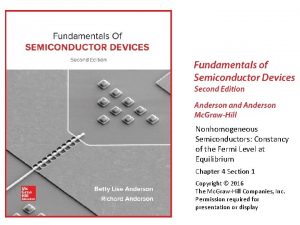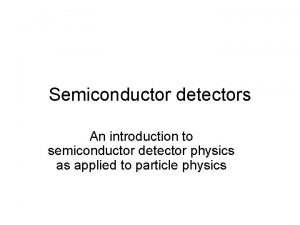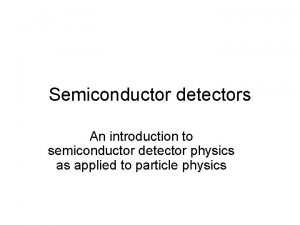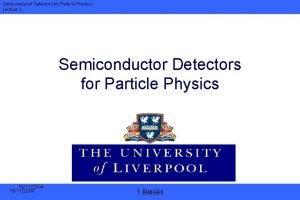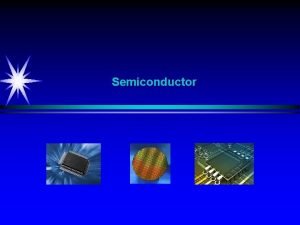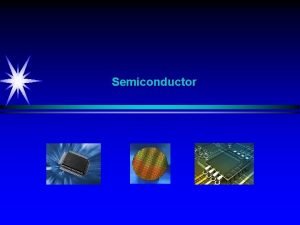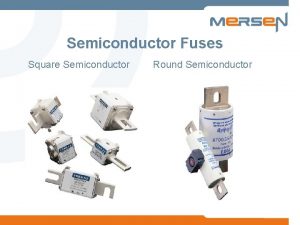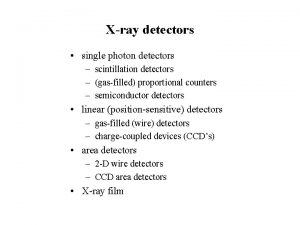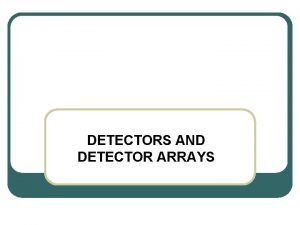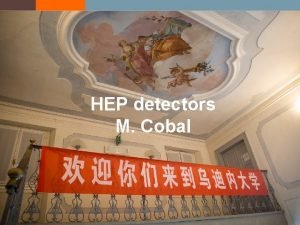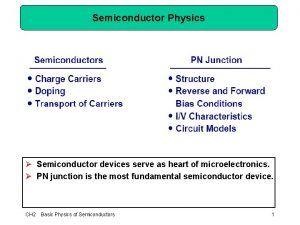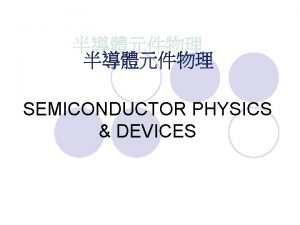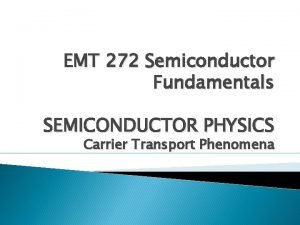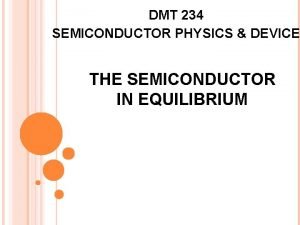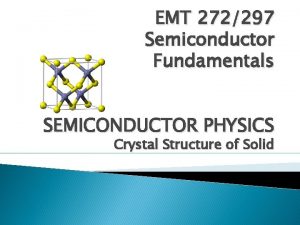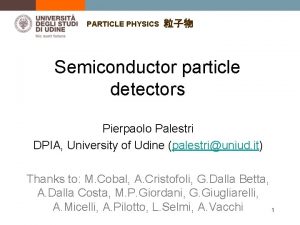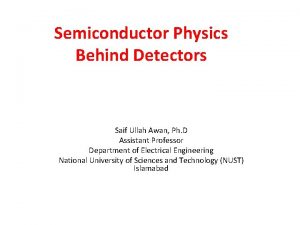Semiconductor detectors An introduction to semiconductor detector physics






















- Slides: 22

Semiconductor detectors An introduction to semiconductor detector physics as applied to particle physics

Contents 4 lectures – can’t cover much of a huge field • • Introduction Fundamentals of operation The micro-strip detector Radiation hardness issues

Lecture 3 – Microstrip detector • Description of device • Carrier diffusion – Why is it (sometimes) good • Charge sharing – Cap coupling – Floating strips • Off line analysis • Performance in magnetic field • Details – AC coupling – Bias resistors – Double sides devices

What is a microstrip detector? • p-i-n diode • Patterned implants as strips – One or both sides • Connect readout electronics to strips • Radiation induced signal on a strip due to passage under/close to strip • Determine position from strip hit info

What does it look like? • • P+ contact on front of n- bulk Implants covered with thin thermal oxide (100 nm) • – The guard ring – Connected to ground – Shields against surface currents – Forms capacitor ~ 10 p. F/cm • Al strip on oxide overlapping implant – Wirebond to amplifier Strips surrounded by a continuous p+ ring • Implants DC connected to bias rail – Use polysilicon resistors MW – Bias rail DC to ground HV Rb

AC coupled strip detector Cfeedback CAC Rbias HV

Capacitive coupling • • Strip detector is a RC network Cstrip to blackplace = 0. 1 x Cinterstrip Csb || Cis ignore Csb Fraction of charge on B due to track at A: B A C

Resolution • Delta electrons – See lecture 2 • Diffusion • Strip pitch – Capacitive coupling – Read all strips – Floating strips • Incident Angle • Lorentz force

Carrier collection • Carriers created around track Φ 1 mm • Drift under E-field – p+ strips on n- bulk – p+ -ve bias – Holes to p+ strips, electrons to n+ back-plane • Typical bias conditions – 100 V, W=300 mm E=3. 3 k. Vcm-1 – Drift velocity: e= 4. 45 x 106 cms-1 & h=1. 6 x 106 cm-1 – Collection time: e=7 ns, h=19 ns

Carrier diffusion • Diffuse due to conc. gradient d. N/dx – Gaussian • Diffusion coefficient: • RMS of the distribution: • Since D m & tcoll 1/m – Width of distribution is the same for e & h • As charge created through depth of substrate – Superposition of Gaussian distribution

Diffusion • Example for electrons: – tcoll = 7 ns; T=20 o. C Ø s = 7 mm • Lower bias wider distribution • For given readout pitch – wider distribution more events over >1 strip – Find centre of gravity of hits better position resolution • Want to fully deplete detector at low bias High Resistivity silicon required

Resolution as a f(V) Spatial resolution as a function of bias Vfd = 50 V • V<50 V – charge created in undeleted region lost, higher noise • V>50 V – reduced drift time and diffusion width less charge sharing more single strips

Resolution due to detector design • Strip pitch – – Very dense Share charge over many strips Reconstruct shape of charge and find Cof. G Signal over too many strips lost signal (low S/N) • BUT – FWHM ~ 10 mm – Technology limited to strip pitch 20 mm • Signal on 1 or 2 strips only for normal incident, no B-field

Two strip events • Track between strips – Find position from signal on 2 strips – Use centre of gravity or – Algorithm that takes into account shape of charge cloud (eta, ) • Track midway between strip Q on both strips – best accuracy • Close to one strip – Small signal on far strip • Apply S/N cut to remove noise hits • Signal lost in noise

Off line analysis • Binary readout – No information on the signal size – Large pitch and high noise • Get a signal on one strip only <x> = 0 P(x) -½ pitch

Floating strips ¡Assume 20 mm strip pitch s = 2. 2 mm • Large Pitch (60 mm) 1/3 tracks on both strips 60 mm 20 mm • Intermediate strip 20 mm Assume s = 2. 2 mm 2/3 on single strips s = 40/ 12 = 11. 5 mm Overall: s = 1/3 x 2. 2 + 2/3 x 11. 5 = 8. 4 mm Capacitive charge coupling 2/3 tracks on both strips NO noise losses due to cap coupling 1/3 tracks on single strips s = 2/3 x 2. 2 + 1/3 x 20/ 12 = 3. 4 mm

Centre of Gravity – Have signal on each strip – Assume linear charge sharing between strips PHL PHR ¡Q on 2 strips & x = 0 at left strip P x ¡e. g. PHL = 1/3 PHR

Eta function – Non linear charge sharing due to Gaussian charge cloud shape PHL P x PHR More signal on RH strip than predicted with uniform charge cloud shape Non-linear function to determine track position from relative pulse heights on strips

Measure Eta function • Testbeam with straight tracks • Reconstruct tracks through detector under test • Measure deposited charge as a function of incident particle track position

Lorentz force • Force on carriers due to magnetic force • Perturbation in drift direction – Charge cloud centre drifts from track position – Asymmetric charge cloud – No charge loss is observed • Can correct for if thickness & B-field known vh E H ve q. L

Details • Modern detectors have integrated capacitors – Thin 100 nm oxide on top of implant – Metallise over this – Readout via second layer • Integrated resistors – Realise via polysilicon • Complex – Punch through biasing • Not radiation hard • Back to back diodes – depleted region has high R

Details • Double sided detectors – Both p- and n-side pattern • Surface charge build up on n-side – Trapped +ve charge in Si. O – Attracts electrons in silicon near surface – Shorts strips together – p+ spray to increase inter-strip resistance
 Frontier detectors for frontier physics
Frontier detectors for frontier physics Introduction to semiconductor physics
Introduction to semiconductor physics Disadvantages of semiconductor detector
Disadvantages of semiconductor detector What are the disadvantages of semiconductor detector
What are the disadvantages of semiconductor detector Diffused junction
Diffused junction Semiconductor detector
Semiconductor detector Where are feature detectors located
Where are feature detectors located Kinesthesis and vestibular sense
Kinesthesis and vestibular sense Feature vectors
Feature vectors Feature detectors
Feature detectors Diagnosing error in object detectors
Diagnosing error in object detectors Photo detectors
Photo detectors Streaming potential
Streaming potential Vhv voltage detectors
Vhv voltage detectors Photo detectors
Photo detectors Nuclear detectors
Nuclear detectors Which detector used in hplc
Which detector used in hplc Giant wave detectors murmurs universe
Giant wave detectors murmurs universe Gravitational wave detectors hear murmurs from
Gravitational wave detectors hear murmurs from Semiconductor lecture
Semiconductor lecture Review of semiconductor physics
Review of semiconductor physics Semiconductor engineering physics
Semiconductor engineering physics Classification of semiconductor
Classification of semiconductor

